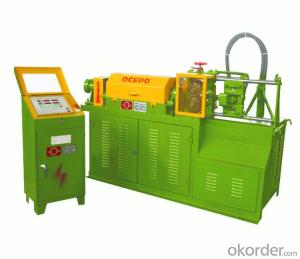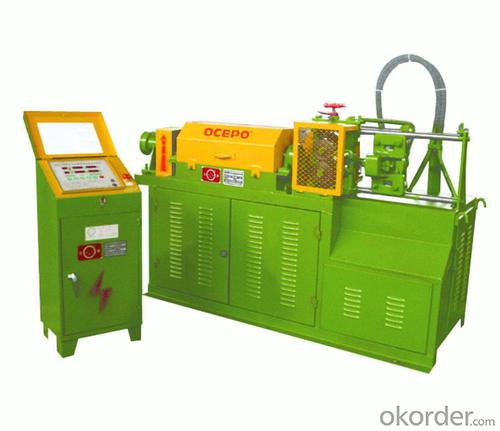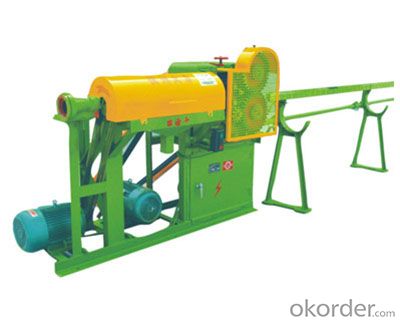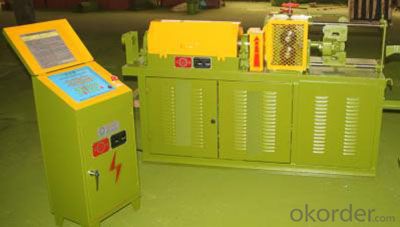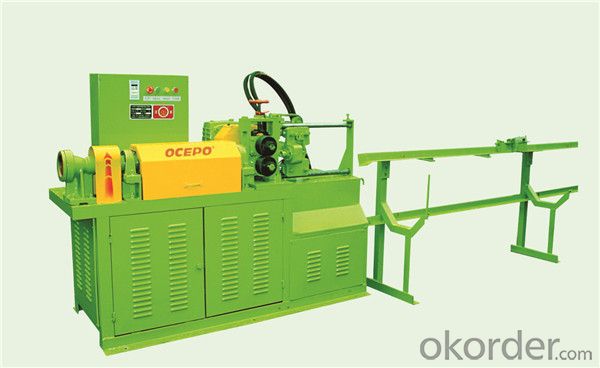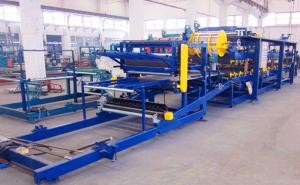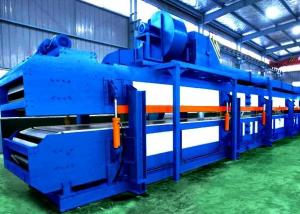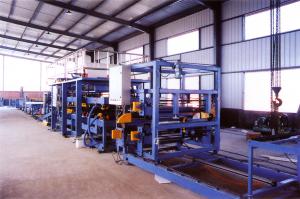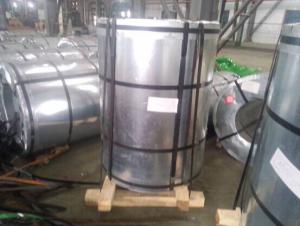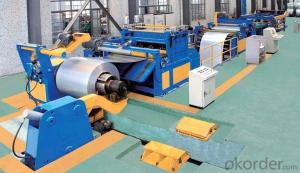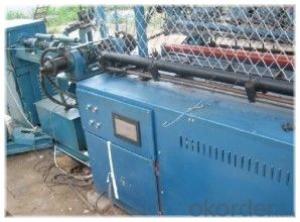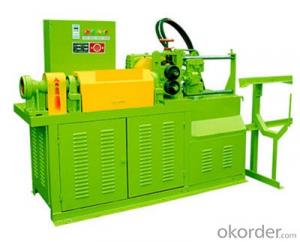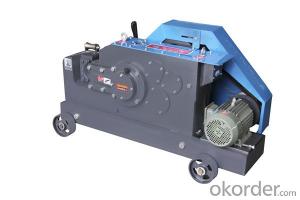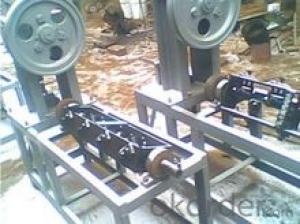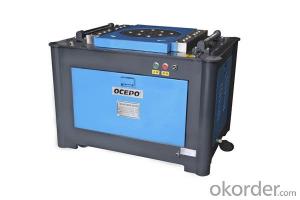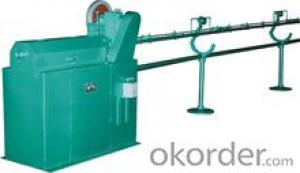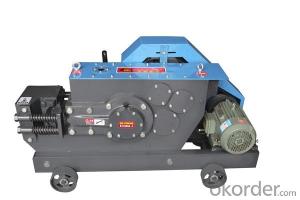CNC machine,Rebar Straightening and Cutting Machine
- Loading Port:
- Tianjin
- Payment Terms:
- TT OR LC
- Min Order Qty:
- 1 unit
- Supply Capability:
- 200 unit/month
OKorder Service Pledge
OKorder Financial Service
You Might Also Like
CNC machine,Rebar Straightening and Cutting Machine
Specification
Straightening Round Bar Dia.
Φ4-Φ12mm
Auto Cutting Length
500-8000mm
Straightening Speed
45m/min
Electromotor for Straightening
Model
Y132M-4
Rated power
7.5Kw
Electromotor for Cutting
Model
Y100L2-4
Rated Power
3.0Kw
Application
The machine is used to straighten and cut round bar (steel rod).
Advantage
1. Numerical control: automatic straightening and cutting, and save labors
2. Smart size and space saving
3. Easy to operate, with fast speed
4. Low material loss
5. Hydraulic cutting, have low noise
Payment
T/T L/C
Delivery
Within one week
Origin
China
Minimum Order
1 set
Packaging
Plywood case
Remarks
OEM & ODM, Buyer Label can be provided.
Packing
Plywood Case
Payment
T/T L/C
Delivery
Within one week
Origin
China
Minimum Order
1 set
Packaging
Plywood case
Remarks
OEM & ODM, Buyer Label can be provided.
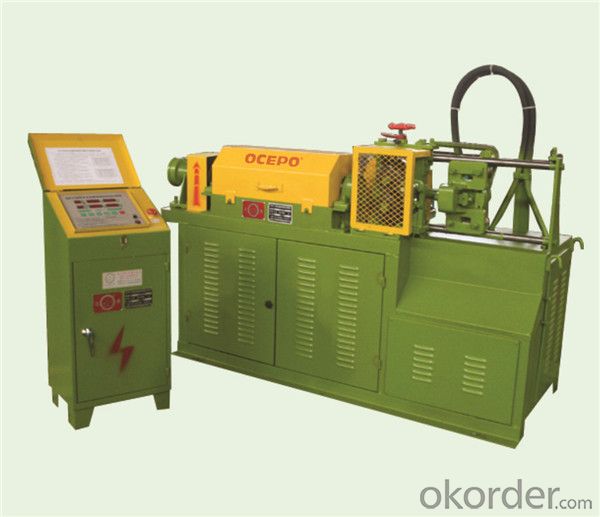
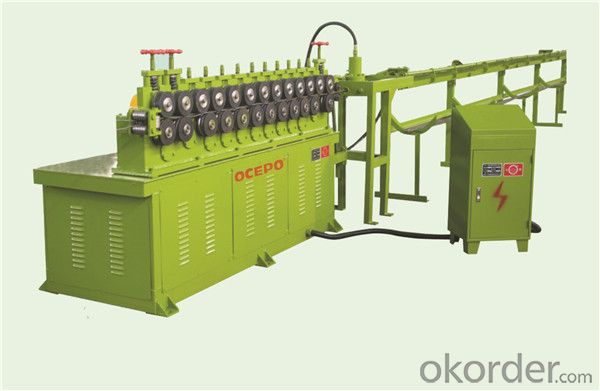
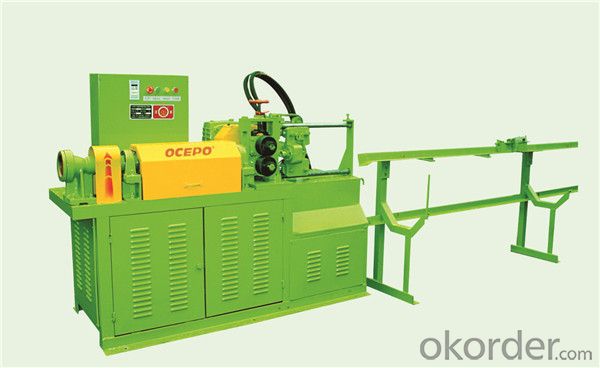

Company Direction
We are China professional manufacturer and system solutions provider of rebar connection machines,rebar processing machines and small road machines.
Founded in the 1990s. For 20 years, it has been focusing on the research, production and sales of rebar connection machines and rebar processing machines. The company is located in the capital of China - Beijing, has strong technical force, complete processing equipment and testing means. All the products are optimized by microcomputer design to reach the advanced level of industry.
- Q: Can metal straightening machinery be used for straightening metal profiles or sections?
- Yes, metal straightening machinery can be used for straightening metal profiles or sections. Metal straightening machinery is specifically designed and built to straighten various types of metal profiles and sections, including beams, channels, angles, and tubes. These machines use different methods such as hydraulic or mechanical force to straighten the metal profiles or sections that may have become warped or bent during the manufacturing process or due to external factors. Metal straightening machinery can effectively apply the necessary force and pressure to reshape and realign the metal profiles or sections, ensuring that they are straight and meet the required specifications and tolerances.
- Q: Can metal straightening machinery be used for delicate or intricate metal parts?
- Metal straightening machinery is typically not recommended for delicate or intricate metal parts. This machinery is designed for heavy-duty applications and may exert excessive force, potentially causing damage to the delicate or intricate parts. It is advisable to use specialized equipment or manual techniques that are more suitable for handling such delicate or intricate metal parts.
- Q: Can this machinery straighten metal with complex shapes or curves?
- Yes, this machinery is specifically designed to straighten metal with complex shapes or curves. It utilizes advanced technology and precision engineering to apply controlled pressure and force to the metal, gradually straightening it out. The machinery is equipped with adjustable components and features that allow for customization and flexibility to accommodate various shapes and curves. It can effectively straighten metals such as steel, aluminum, and copper, regardless of the complexity of their shapes or curves.
- Q: How long does it take to straighten metal using this machinery?
- The time it takes to straighten metal using this machinery can vary depending on several factors such as the type and thickness of the metal, the condition of the metal, and the specific machinery being used. Generally, the process of straightening metal involves applying pressure or force to bend the metal back into its original shape. For smaller or less damaged pieces of metal, the straightening process can be relatively quick and may only take a few minutes. However, for larger or more severely bent pieces, the process may take longer and could require several attempts to fully straighten the metal. It's important to note that the skill and experience of the operator can also impact the time it takes to straighten the metal. A skilled operator who is familiar with the machinery and techniques may be able to complete the process more efficiently. Overall, it is difficult to provide an exact timeframe without additional information about the metal and machinery being used. It would be best to consult with the manufacturer or an expert in metal straightening to get a more accurate estimate for your specific situation.
- Q: What are the different methods of correcting for twist or torsion during straightening using this machinery?
- There are multiple techniques available for rectifying twist or torsion while using this equipment. One commonly employed approach involves modifying the tension exerted on the material being straightened. By either increasing or decreasing the tension on specific sections of the material, it is feasible to counteract the twisting or torsion forces and restore the material to its original straight form. Another method entails utilizing a roller straightening process. This technique requires guiding the material through a sequence of strategically positioned rollers that apply pressure and compel the material to straighten. The angle and placement of the rollers can be adjusted to target particular areas of the material that require correction for twist or torsion. In certain instances, heat can be utilized as a means of rectifying twist or torsion. By subjecting the affected areas of the material to heat, the material becomes more pliable and can be easily manipulated to eliminate any twists or torsions. This method is frequently employed for materials that have undergone significant twisting or possess a high degree of torsion. Furthermore, specific equipment may possess specialized attachments or tools that are capable of rectifying twist or torsion. These attachments can be designed to exert pressure or force on specific areas in order to counteract the twisting or torsion effect. The utilization of these tools enables more precise and targeted correction for twist or torsion. In summary, the various methods for correcting twist or torsion during straightening using this machinery encompass tension adjustment, roller straightening, heat application, and specialized attachments or tools. The selection of the method depends on the severity of the twist or torsion, the type of material being straightened, and the capabilities of the machinery.
- Q: How can the operator training for metal straightening machinery be conducted?
- Operator training for metal straightening machinery can be conducted through a combination of theoretical learning and practical hands-on experience. This can involve classroom-based training sessions where operators learn about the principles of metal straightening, safety protocols, and machine operation. Additionally, on-the-job training with experienced operators can provide valuable practical knowledge and skills. Regular assessments and evaluations should also be conducted to ensure operators are proficient in operating the machinery safely and efficiently.
- Q: Can metal straightening machinery be used for straightening gears or splines?
- Yes, metal straightening machinery can be used for straightening gears or splines. Metal straightening machinery is designed to apply controlled pressure and force to deformations in metal components, such as bends, twists, or warps, in order to restore their original shape and alignment. Gears and splines, which are critical components in various mechanical systems, can often become distorted or misaligned due to factors such as wear, heat, or improper handling. Metal straightening machinery can effectively address these issues by exerting the necessary corrective forces on the affected areas of the gears or splines, allowing them to be straightened and restored to their intended shape and functionality. However, it is important to ensure that the metal straightening machinery being used is specifically designed and suitable for the dimensions and specifications of the gears or splines being straightened, as different types of machinery may have varying capabilities and limitations.
- Q: Can metal straightening machinery be used for straightening metal profiles and sections with varying cross-sections?
- Yes, metal straightening machinery can be used for straightening metal profiles and sections with varying cross-sections. Metal straightening machinery is designed to apply controlled pressure and force to deform and reshape metal sections, resulting in straightening of the material. These machines typically have adjustable rollers or dies that can accommodate varying cross-sections, allowing them to straighten metal profiles and sections of different shapes and sizes. The operator can adjust the machine according to the specific dimensions and cross-sections of the metal being straightened, ensuring accurate and consistent results. Therefore, metal straightening machinery is versatile and can effectively straighten metal profiles and sections with varying cross-sections.
- Q: What are the common control algorithms used in metal straightening machinery?
- Some common control algorithms used in metal straightening machinery include proportional-integral-derivative (PID) control, adaptive control, and fuzzy logic control. These algorithms are utilized to achieve accurate and precise control of the straightening process by monitoring and adjusting various parameters such as force, speed, and position.
- Q: What are the safety interlocks in place for metal straightening machinery?
- Safety interlocks in metal straightening machinery are essential to prevent accidents and ensure the protection of workers. These interlocks are designed to minimize risks associated with the operation of such machinery by incorporating various safety measures. One common safety interlock is the presence sensor, which detects the presence of a worker near the machine. This sensor prevents the machine from starting or continuing operation if someone is in the immediate vicinity, reducing the risk of accidental injury. Additionally, a light curtain or laser scanner may be installed as a safety interlock to create a barrier around the machine, ensuring that it automatically stops when an object or person enters the designated safety zone. Emergency stop buttons are another crucial safety interlock that can be found on metal straightening machinery. These buttons are easily accessible and allow workers to quickly shut down the machine in case of an emergency or imminent danger. This immediate response can prevent accidents and minimize the severity of injuries. Furthermore, interlocks can be implemented to ensure that the machine operates only in specific conditions or with specific parameters. For example, a safety interlock may require the use of personal protective equipment (PPE), such as safety glasses or gloves, before allowing the machine to function. This ensures that operators are properly protected and reduces the risk of injury. In addition to these interlocks, metal straightening machinery may also feature overload protection systems. These systems monitor the operating parameters of the machine and automatically shut it down if it exceeds safe limits. This prevents potential damage to the machinery and reduces the risk of accidents caused by overloading. Regular maintenance and inspections of the safety interlocks are essential to ensure their effectiveness. It is crucial for employers to provide adequate training to workers on the proper use of these safety interlocks and to enforce their utilization to create a safe working environment. Overall, safety interlocks in metal straightening machinery play a critical role in protecting workers from accidents and ensuring their well-being. These interlocks, such as presence sensors, emergency stop buttons, PPE requirements, and overload protection systems, are vital components in minimizing risks and maintaining a safe workplace.
Send your message to us
CNC machine,Rebar Straightening and Cutting Machine
- Loading Port:
- Tianjin
- Payment Terms:
- TT OR LC
- Min Order Qty:
- 1 unit
- Supply Capability:
- 200 unit/month
OKorder Service Pledge
OKorder Financial Service
Similar products
Hot Searches
Related keywords
